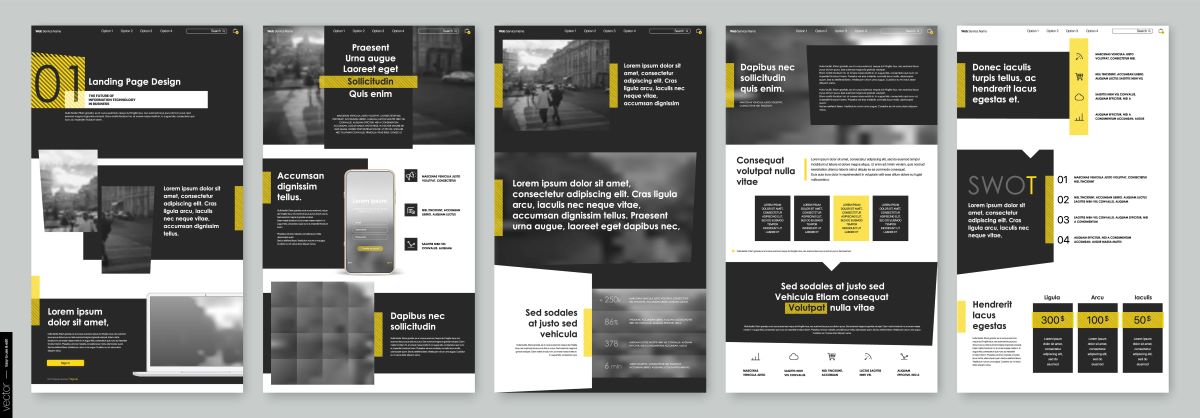The most important function of a website for any business is how successfully it generates new revenue. Ecommerce websites need to sell product. Business service websites need to attract and convert visitors into leads or clients. Savvy marketers know that performance-driven websites are the lynchpin in an effective marketing strategy, serving as the core of the marketing funnel and the hub of brand communication. The latest trends and technological advancements in mobile devices and user navigation are pushing web design to new, more streamlined and productive paths that help us to take full advantage of their customer conversion potential.
How do you create a website that converts?
A successful website will capitalize on the critical factors of the Internet’s search and sorting algorithms, as well as customer psychology and browsing patterns, to ensure the content is right for the user and they feel motivated to take action. The number of successful conversions determines the effectiveness of a website. Every business owner wants optimized website conversion. A business can have more than 10,000 visitors but get zero sales from the visitors, making the website unproductive.
However, if you have 1000 visitors and more than half end up signing up or purchasing items, it shows the website is functional. Your brand’s trajectory depends on how you package and present your website to your potential customers. It’s essential to position your website and digital marketing channels in a way that efficiently and speedily targets your customers.

Key Elements to Consider When Creating a Website
In order to create a website that converts, one that successfully turns website visitors into paying customers or captured leads, the following vital elements must be in place.
Strategy
Everyone has a website to sell their products and services or interact with their audience. Every website has a unique presentation that serves the objectives and needs of the business. Before creating a website, you need to identify and understand what your website will achieve and who is the intended audience. What kind of information will you be conveying to your customers? Do you have unique selling points? Have you identified your differentiators?
Understanding your target market and their persona is the next step. Your website needs to communicate with the target audience thoroughly, and in a way that is native to their preferred communication style. Visitors are more likely to return to a website if they feel it is valuable or resourceful during their first visit. Research and understand the demographics of the people visiting your website so you know what to say to them and how to say it.
What is the goal of starting a website? Are you trying to drive traffic, attract more readers, and increase subscriptions or sales? Identifying the most critical goals for creating a website will help develop the best website conversion strategies. Building a functional and productive website isn’t easy. Strategic planning and execution of ideas are essential from the launch to the website’s conception.
User Interface (UI)
Website design is more than a beautiful layout and excellent graphics. Businesses need to consider plenty of factors so that their websites are impressive and achieve conversions. The structure you pick for your website must be professional and resonate well with your brand’s voice. Optimized user experience plays a vital role in triggering conversions. Visitors want a website they can easily navigate and use. Hence it’s paramount to implement various factors to enhance user experience.
Mobile internet has become more prevalent than desktop internet. Mobile optimization of your website makes it easier for customers to access it from their mobile devices. Ensure the features and aesthetics available on the desktop version are present in the mobile version. The website’s layout should be simple and have a Call to Action. Every website page should be easy to navigate, with straightforward content that provides a deeper understanding of your services.
Opting for simple aesthetics makes your website less complicated. Only include the most critical aesthetics and options on your website. Websites that are more aesthetically pleasing have better conversion. Your brand identity should remain clear and visible in every part of the website. Visitors should easily spot your brand in crucial parts of the website, like the logo, style, fonts, and color scheme.
User Experience (UX)
The user interface will attract visitors to your website, but what impression will they have after going through it? User experience determines whether you will lose or retain the visitor. It’s the key path to create a website that converts. Most users want a speedy, accurate, and informative user experience when they access any website. The user experience can be the breaking point and determinant of a successful conversion or not.
How fast can the user navigate and access the various tabs available on the website? A great user experience is achieved by a simple website layout that is predictable. The navigation bars and menus would be visible on every web page. The “Call to Action” needs to be placed strategically and easily accessible at every point of the visitor’s journey.
The speed and responsiveness of your website can give a positive or negative user experience. Users want websites that can load very fast, giving them timely access to information. The website should have minimal taps or clicks before the users can reach their destinations. Increase the user experience of your visitors by having a responsive website that hastily catches their attention on the first click.
The last part of achieving optimal user experience is making your website interactive. Visitors should easily access all the products and services on the website. The clickable buttons should direct the visitors to the correct page and provide the relevant information.

Content
Content is King and one of the essential elements of the best converting websites on the Internet. A website without content is just a template. Content is one aspect of the website that remains paramount and consistent throughout the life of the website. Content doesn’t only include written text but also audio, images and video. The content you opt for should represent your niche while effectively connecting with your audience by explaining in clear, direct language what you’re offering and what you want the user to do.
The written content needs to be well-researched and carefully drafted. Proper use of the correct keywords and phrases is essential. Users are likely to frequent a more educational website than one that is more sales-oriented. The written content should give your audience the answers they are searching for. Every word on the platform should add value to the visitor.
Quality illustrative and graphic elements help in breaking content monotony. Illustrative elements should market your brand to the readers at all times. Your exemplary details need to be fun, entertaining, and educational. They shouldn’t sway the visitor from the original content.
Images, video, and audio are significant. The current generation of internet users is thrilled with the impressive audiovisual presentation of products and services. They will respond to a video that is fun and educational at the same time. Combining fun and information in the media will ensure your website is very productive and resourceful to your clients.
The FAQ section is integral to your website, providing additional content about your brand, products, and services. Have real questions in your FAQ section and provide valuable and accurate answers. The FAQ section can bolster and show your deep understanding and expertise in the industry.
Search Engine Optimization
High ranking in search engines is the primary goal of many websites. Search engines highly rank reputable websites. Therefore if the target market can’t find your website on the search engines, it doesn’t exist or lacks a digital footprint. Your website should appear in the top search results on any search engine. SEO is an essential component of any online platform. Different aspects of SEO play a role in ensuring a website ranks highly.
On-page resources refer to any tool or resource available on your website that you can customize to increase the website’s ranking.
These resources include:
- Page titles
- URL Structure
- Internal linking
- Meta tags and description
- Body tags
- Use of correct keywords
- Optimal keyword density
- Optimizing images
Off-page activities are measures you can implement off the website that will promote its online ranking. Popular off-page strategies include social networking, business directory submissions, blog submissions, link building, etc. Off-page procedures ensure you get recognition by being recognized and mentioned by third-party websites or platforms.
Linking is crucial in any website. There are two main types of linking: external and internal linking. Linking plays a pivotal role in promoting the SEO of your website. Internal links connect the content on your website, providing search engines with a simple explanation of your website structure. Additionally, they prioritize the different pages on the website based on their importance. External links can direct visitors to other online platforms of your brands, hence creating more brand awareness.

Crucial Information
Visitors can only turn into actual leads when they can access important information. Crucial information varies depending on the niche or the industry on your website. A cafe website should have a detailed menu, giving visitors a glimpse of the meals. Provide as much information as possible about your products and services. Don’t forget to update the contact information on your website frequently.
The contact information should be easy to find on the website, making it easy for visitors to contact you. Providing frequent events updates will keep your visitors interested in the activities of your website. An eCommerce website can create event notifications for its buyers, reminding them of an incoming mega sale. Always remember to pull down notifications once the event has ended.
Trust Factors
A whopping 18% of all purchases are made online. However, buyers are still skeptical of being scammed or getting low-quality products from online purchases. Your website must convey trust to your target audience, assuring them of high quality before and after purchasing. One popular way to build trust in the online community is by asking your loyal customers to leave reviews after making any purchase. Visitors are more likely to believe reviews that verified buyers write. Thanks to audiovisual presentations, customers can submit different reviews, from written to audio to even video. Encourage your customers to be as detailed as possible in their reviews.
If you are in professional practice, you should include your certifications and awards on your website. The certificates and awards show your commitment to your profession and how hard you worked to get them. It’s vital to include updated licensing information. Other information that can increase the trust and credibility of your website includes testimonials, case studies, and recognitions. Don’t be afraid to include any recognition in your niche that you have received.
You can also build trust by responding to complaints from past clients. Professionally and promptly handling any complaint will show visitors that you care about your clients before and after making a purchase.
Call to Action
To create a website that converts, you must have easy and clear ways for users to take a converting action. The “Call to Action” (CTA) is the final guide to your target market on what they should do after being wowed by your website. You don’t need to risk the ship sinking before docking by having a mediocre “Call to Action .” Popular examples of CTAs are:
- Consultation Forms
- Sign Up options
- “Contact us” buttons
- Add to Cart
- Social media sharing icons
- Subscribing
Website conversion is easy when you have more than one CTA on your website. Include one “Call to Action” in each webpage; they shouldn’t be overbearing to visitors. The CTA should be relevant and resonate well with the visitor’s journey. Someone exploring a blog will expect a CTA focusing on getting more content like the “Sign Up” option. If your CTA is a contact us option, provide as many options as possible, from live chat, emails, and phone numbers to contact forms.
Let us Help You Create a Website that Converts!
Every website is different and requires different web optimization strategies and tactics to achieve optimum conversions. The above tips, however, can be used in every website from any niche or specialty. The trick to maintaining and increasing website conversion is adapting to the various trends and changes in the industry and digital marketing. Website conversions depend on effective digital marketing, starting from optimized content creation in website creation to maintaining trust and reliability among your customers.
With the above expert tips, we are confident you can create a website for your company or business that will achieve maximum website conversion and increased sales.
Contact a Signal representative today for a free consultation call to see what we can do for your brand on the web!





